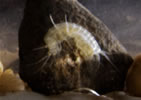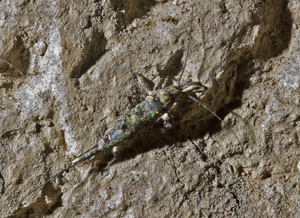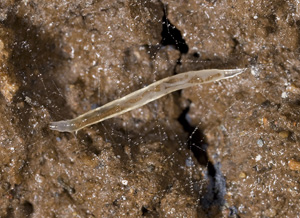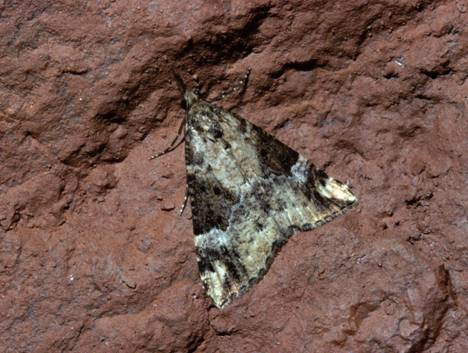There are many cave species in this group including some troglobites, although (with the exception of Speolepta) these have mostly been recorded from caves elsewhere in Britain.
The springtails (in the Collembola group) are an ancient group of arthropods, similar forms have been found as fossils that are around 400 million years old. They are wingless ground dwelling insects that require high humidity. Many species have been found in caves, including the rare Disparrhopalites patrizi, whose only known British record is from the Rock House caves, Buckfastleigh . They are called springtails due to their ability to leap about with the aid of a trigger or ‘spring’. Soil and underground species appear to have evolved a smaller spring, shorter legs and antennae, reduction in eyes and loss of pigment. They feed on fungal mycelia, bacteria, decomposing plant and animal material. Not all springtails seem to jump - some walk about on the surface as if they are grazing.
Springtails are most easily found on the surface of pools, some are so small (1mm) they will look like specks of white dust to begin with, but if you observe them for perhaps a minute one might leap a couple of inches – enough to convince you that it is actually alive. They are so light and small they can move about on top of the surface film of the water. Best places to look are still pools and damp mud banks.
Bristletails (Thysanura) might occasionally turn up in the soil and leaf litter in the threshold zone of caves. They are small insects covered with scales and have three tails (cerci) on their rear. They include the silverfish sometimes found in sheds and houses. Trigoniophthalmus alternatus is a winter threshold species in several Devon caves, with the main colony in the Higher Kiln Quarry. Almost all British records of this species have been from South Devon and it has not been recorded from caves elsewhere.
|
Bristletail at entrance to Pridhamsleigh Cavern
|
Diplurans ('two tailed bristletails’) are primitive eyeless insects with segmented antennae that generally live underground in soil and leaf litter. They resemble white earwigs and live on prey and dead organic matter including springtails and fungi. They are unusual in that they are able to regenerate lost body parts. On some species the tails (cerci) are used as pincers, the one in the photograph has very small tails but long antennae and a droplet of water on its back.
Mayflies (Ephemeroptera), stoneflies (Plecoptera) and caddis flies (Trichoptera) have nymphs that live in streams and rivers for a few years before becoming an adult fly that may only live for a few days. Their nymphs are probably washed into caves from outside. Plectrocnemia (Trichoptera) larvae have been recorded in the stream in Baker’s Pit and from Great Rock Mine. Adults of the large buff coloured caddisfly Stenophylax permistus use the cave threshold as a resting stage for part of the summer - it has been recorded Bickington Pot, Rock House Caves and several other sites.
Many species of fly (Diptera)are found in caves but most are visitors. They are often found in the same place year after year. Craneflies visit the threshold in summer, they do not feed as adults. The crane fly Limonia nubeculosa is often found in cave thresholds as a summer visitor – it rests with its speckled brown wings covering its abdomen unlike many crane flies. Outside it is found all year round. There are often many in the threshold of caves and it has been recorded from Bickington Pot, Great Rock Mine, Penn Recca Mine and Haw Cave.
Dungflies e.g. Leria serrata (previously known as Heleomyza) visit the threshold – they arrive in autumn and remain until starvation or fungal attack. Maybe they settle somewhere dry in the dark zone in winter and get caught out as air current reverses in summer with the corresponding rise in humidity and condensation. This dampness is ideal for the fungi to attack them.Adults are found all year round in the cave, but the reason why is not clear.
Fungus gnats (Mycetophilidae) such as Speolepta leptogaster are numerous in caves, some consider it a troglobite. The yellow headed transluscent larva (14mm) live in a web of thin threads (looks a bit like a sheet spiders web), and probably live on bacteria and fungi. The tangled mass of threads is to keep the insect from touching the walls, becoming wet and then falling prey to fungi. They can be seen along the walls of Rift Cave in the Higher Kiln Quarry and have been recorded from several other caves in the county.
|
Larva of the Fungus gnat, Speolepta leptogaster, suspended in silk threads, Rift Cave. |
Sciara gnats are similar to fungus gnats but the larva has a black head capsule.
The winter gnat Trichocera maculipennis is found deep in large cave systems elsewhere in Britain but only a single Trichocera larva has been recorded from Levaton cave in Devon.
The common mosquito (Culex pipiens) - inseminated females overwinter in cave thresholds and then leave the cave in spring for a blood meal, usually from a bird (not from humans). There are several generations a year.
Several species of moth overwinter in the cave threshold (they do move around the cave during this time). The Herald moth (Scoliopteryx libatrix) is common in cave entrances such as Kitley Cave, Napp’s Cave and Bulkamore Iron Mine. The Herald moth is often found in the dark zone beaded in moisture, it stays up to 10 months underground – it is unlikely this is all hibernation so why does it spend all this time in the cave? It may be for the ovaries to develop. It keeps its head pointing away from the light. The caterpillar eats willow and poplar. The Tissue Moth (Trichosa dubitata) is common in caves elsewhere in Britain but rare in Devon and there are no cave records so far, though with further recording it will probably turn up. The Tissue moth settles closer to the entrance and lower down the wall than the Herald moth and the caterpillar eats buckthorn and blackthorn. A further species, found in caves near the sea, is the Bloxworth Snout (Hypena obsitalis). Formerly a rare migrant moth it was first recorded breeding in Britain in 1990 in Torbay; it is now the commonest moth in caves around Torbay and has been found inland to Afton Red Rift. It is also known from Dorset and Cornwall. The Many-plumed moth (Alucita hexadactyla) has been recorded in Rift Cave, Paignton Zoo Caves, and Afton Red Rift.
Peacock butterflies (Inachis io) can sometimes be found hibernating in cave thresholds: they have been recorded in Draughting Cave, Berry Head, Spiders Cave in Higher Kiln Quarry and Afton Red Rift.
Fleas are common on bats. They are small wingless parasites noted for their ability to leap.
Beetles - many species are cavernicoles. A variety of species can potentially be found in the threshold of caves but the ones most likely to be found deeper underground are members of the ground beetle (Carabidae) and rove beetle (Staphylinidae) families. In Devon the ground beetle Trechus fulvus and the rove beetle Quedius mesomelinus are the two most common species found in caves. The former has been recorded in Baker’s Pit, Penn Recca and Pridhamsleigh. The latter has been recorded in Baker’s Pit, Bickington Pot, Joint-Mitnor, Pridhamsleigh, Radford and Reed’s. Another genus of rove beetle, Lesteva has also been recorded from Great Rock Mine, Fairy Hall Quarry Cave and Penn Recca.
Water and diving beetles are found in caves but are more common elsewhere in the country, where active streamway passage is more likely to be found. The diving beetle Agabus guttatus has been recorded in Fairy Hall Quarry Cave, Haytor Iron Mine and Great Rock Mine. On the surface the species is usually associated with springs and spring-fed pools.
|




